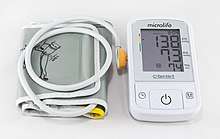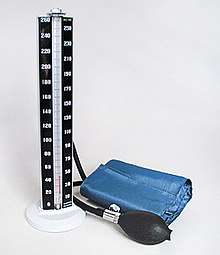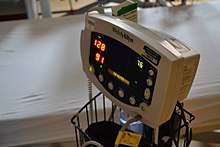Sphygmomanometer
A sphygmomanometer, also known as a blood pressure meter, blood pressure monitor, or blood pressure gauge, is a device used to measure blood pressure, composed of an inflatable cuff to collapse and then release the artery under the cuff in a controlled manner,[1] and a mercury or aneroid manometer to measure the pressure. It is always used with a means to determine at what pressure blood flow is just starting, and at what pressure it is unimpeded. Manual sphygmomanometers are used with a stethoscope when using the auscultatory technique.
A sphygmomanometer consists of an inflatable cuff, a measuring unit (the mercury manometer, or aneroid gauge), and a mechanism for inflation which may be a manually operated bulb and valve or a pump operated electrically.
Types
Both manual and digital meters are currently employed, with different trade-offs in accuracy versus convenience.
Manual
A stethoscope is required for auscultation (see below). Manual meters are best used by trained practitioners, and, while it is possible to obtain a basic reading through palpation alone, this yields only the systolic pressure.
- Mercury sphygmomanometers are considered the gold standard. They indicate pressure with a column of mercury, which does not require recalibration.[2] Because of their accuracy, they are often used in clinical trials of drugs and in clinical evaluations of high-risk patients, including pregnant women. A frequently used wall mounted mercury sphygmomanometer is also known as a Baumanometer®.[3]
- Aneroid sphygmomanometers (mechanical types with a dial) are in common use; they may require calibration checks, unlike mercury manometers. Aneroid sphygmomanometers are considered safer than mercury sphygmomanometers, although inexpensive ones are less accurate.[4] A major cause of departure from calibration is mechanical jarring. Aneroids mounted on walls or stands are not susceptible to this particular problem.
Digital
Digital meters employ oscillometric measurements and electronic calculations rather than auscultation. They may use manual or automatic inflation, but both types are electronic, easy to operate without training, and can be used in noisy environments. They measure systolic and diastolic pressures by oscillometric detection, employing either deformable membranes that are measured using differential capacitance, or differential piezoresistance, and they include a microprocessor.[5] They accurately measure mean blood pressure and pulse rate, while systolic and diastolic pressures are obtained less accurately than with manual meters,[6] and calibration is also a concern.[7][8][9] Digital oscillometric monitors may not be advisable for some patients, such as those suffering from arteriosclerosis, arrhythmia, preeclampsia, pulsus alternans, and pulsus paradoxus, as their calculations may not correct for these conditions,[10][11] and in these cases, an analog sphygmomanometer is preferable when used by a trained person.
Digital instruments may use a cuff placed, in order of accuracy[12] and inverse order of portability and convenience, around the upper arm, the wrist, or a finger.[13] Recently, a group of researchers at Michigan State University developed a smartphone based device that uses oscillometry to estimate blood pressure.[14][15] The oscillometric method of detection used gives blood pressure readings that differ from those determined by auscultation, and vary according to many factors, such as pulse pressure, heart rate and arterial stiffness,[16] although some instruments are claimed also to measure arterial stiffness, and some can detect irregular heartbeats.
Operation
In humans, the cuff is normally placed smoothly and snugly around an upper arm, at roughly the same vertical height as the heart while the subject is seated with the arm supported. Other sites of placement depend on species and may include the flipper or tail. It is essential that the correct size of cuff is selected for the patient. Too small a cuff results in too high a pressure, while too large a cuff results in too low a pressure. For clinical measurements it is usual to measure and record both arms in the initial consultation to determine if the pressure is significantly higher in one arm than the other. A difference of 10 mm Hg may be a sign of coarctation of the aorta. If the arms read differently, the higher reading arm would be used for later readings. The cuff is inflated until the artery is completely occluded.
With a manual instrument, listening with a stethoscope to the brachial artery at the elbow, the examiner slowly releases the pressure in the cuff. As the pressure in the cuffs falls, a "whooshing" or pounding sound is heard (see Korotkoff sounds) when blood flow first starts again in the artery. The pressure at which this sound began is noted and recorded as the systolic blood pressure. The cuff pressure is further released until the sound can no longer be heard. This is recorded as the diastolic blood pressure. In noisy environments where auscultation is impossible (such as the scenes often encountered in emergency medicine), systolic blood pressure alone may be read by releasing the pressure until a radial pulse is palpated (felt). In veterinary medicine, auscultation is rarely of use, and palpation or visualization of pulse distal to the sphygmomanometer is used to detect systolic pressure.
Digital instruments use a cuff which may be placed, according to the instrument, around the upper arm, wrist, or a finger, in all cases elevated to the same height as the heart. They inflate the cuff and gradually reduce the pressure in the same way as a manual meter, and measure blood pressures by the oscillometric method.[5]
Significance
By observing the mercury in the column, or the aneroid gauge pointer, while releasing the air pressure with a control valve, the operator notes the values of the blood pressure in mm Hg. The peak pressure in the arteries during the cardiac cycle is the systolic pressure, and the lowest pressure (at the resting phase of the cardiac cycle) is the diastolic pressure. A stethoscope is used in the auscultatory method. Systolic pressure (first phase) is identified with the first of the continuous Korotkoff sounds. Diastolic pressure is identified at the moment the Korotkoff sounds disappear (fifth phase).
Measurement of the blood pressure is carried out in the diagnosis and treatment of hypertension (high blood pressure), and in many other healthcare scenarios.
History
The sphygmomanometer was invented by Samuel Siegfried Karl Ritter von Basch in the year 1881.[1] Scipione Riva-Rocci introduced a more easily used version in 1896. In 1901, pioneering neurosurgeon Dr. Harvey Cushing brought an example of Riva-Rocci's device to the US, modernized it and popularized it within the medical community. Further improvement came in 1905 when Russian physician Nikolai Korotkov included diastolic blood pressure measurement following his discovery of "Korotkoff sounds." William A. Baum invented the Baumanometer® brand in 1916,[17] while working for a doctors' group that handled insurance and employment physicals.[3] In 1981 the first fully automated oscillometric blood pressure cuff was invented by Donald Nunn.[18]
Etymology
The word sphygmomanometer (/ˌsfɪɡmoʊməˈnɒmɪtər/, SFIG-moh-mə-NOM-i-tər) uses the combining form of sphygmo- + manometer. The roots involved are as follows: Greek σφυγμός sphygmos "pulse", plus the scientific term manometer (from French manomètre), i.e. "pressure meter", itself coined from μανός manos "thin, sparse", and μέτρον metron "measure".[19][20][21]
Most sphygmomanometers were mechanical gauges with dial faces, or mercury columns, during most of the 20th century. Since the advent of electronic medical devices, names such as "meter" and "monitor" can also apply, as devices can automatically monitor blood pressure on an ongoing basis.
References
- Booth, J (1977). "A short history of blood pressure measurement". Proceedings of the Royal Society of Medicine. 70 (11): 793–9. doi:10.1177/003591577707001112. PMC 1543468. PMID 341169.
- "Comparing Mercury and Aneroid Sphygmomanometers". Sustainable Hospitals / Lowell Center for Sustainable Production. Sustainable Hospitals / Lowell Center for Sustainable Production. 2003. Retrieved 23 February 2015.
- "Turning Mercury Into Solid Gold". nytimes.com. 2005-03-27. Retrieved 2018-07-05.
- Misrin, J. "Aneroid Sphygmomanometer: A Battle for Safer Blood Pressure Apparatus". Retrieved 27 February 2012.
- Oscillometry, Explanation of oscillometric detection in Medical Electronics, N Townsend, p48-51
- "Oscillometric Method - Methods of Blood Pressure Measurement - Measurement of Blood PressureMethods of Blood Pressure Measurement -". www.severehypertension.net. Retrieved 2017-04-13.
- Can we trust automatic sphygmomanometer validations? Turner MJ. Journal of Hypertension. 28(12), December 2010, pp. 2353–2356 doi:10.1097/HJH.0b013e32833e1011.
- Automated Sphygmomanometers Should Not Replace Manual Ones, Based on Current Evidence Martin J. Turner and Johan M. van Schalkwyk American Journal of Hypertension. 21(8), p. 845.
- Sphygmomanometer calibration--why, how and how often? Turner MJ1, Speechly C, Bignell N. Australian Family Physician. October 2007; 36(10):834-838.
- Hamzaoui O, Monnet X, Teboul JL (2013). "Pulsus paradoxus". Eur. Respir. J. 42 (6): 1696–705. doi:10.1183/09031936.00138912. PMID 23222878.
- O'Brien E, Asmar R, Beilin L, Imai Y, Mallion JM, Mancia G, Mengden T, Myers M, Padfield P, Palatini P, Parati G, Pickering T, Redon J, Staessen J, Stergiou G, Verdecchia P (2003). "European Society of Hypertension recommendations for conventional, ambulatory and home blood pressure measurement". J. Hypertens. 21 (5): 821–48. doi:10.1097/00004872-200305000-00001. PMID 12714851.
- Inaccuracy of wrist-cuff oscillometric blood pressure devices: an arm position artefact? Adnan Mourad, Alastair Gillies, Shane Carney, Clinical methods and pathophysiology
- "Blutdruckmessgerät - Handgelenk - Blutdruckmessgerät - Test" (in German). Blutdruckmessgeraet-vergleich-test.de. Retrieved 27 September 2016.
- Chandrasekhar, Anand (2018-03-07). "Smartphone-based blood pressure monitoring via the oscillometric finger-pressing method". Science Translational Medicine. 10 (431): eaap8674. doi:10.1126/scitranslmed.aap8674. PMC 6039119. PMID 29515001.
- Chandrasekhar, Anand (2018-09-03). "An iPhone Application for Blood Pressure Monitoring via the Oscillometric Finger Pressing Method". Scientific Reports. 8 (1): 13136. doi:10.1038/s41598-018-31632-x. PMC 6120863. PMID 30177793.
- van Montfrans GA (2001). "Oscillometric blood pressure measurement: progress and problems". Blood Press Monit. 6 (6): 287–90. doi:10.1097/00126097-200112000-00004. PMID 12055403.
- U.S patent 1594039 Manometer
- Apparatus and method for measuring blood pressure
- Harper, Douglas. "sphygmomanometer". Online Etymology Dictionary.
- Harper, Douglas. "manometer". Online Etymology Dictionary.
- σφυγμός, μανός, μέτρον. Liddell, Henry George; Scott, Robert; A Greek–English Lexicon at the Perseus Project.
External links
| Wikimedia Commons has media related to Sphygmomanometers. |
- US patent 1089122, Francis Ashley Faught, Charles J Pilling, "Apparatus for measuring and indicating blood-pressure", issued 1914-03-03
- US patent 1594039, William A Baum, "Manometer", issued 1926-07-27
- US patent 2560237, R. H. Miller, "Sphygmomanometer", issued 1951-07-10
- US patent 6752764, Man S. Oh, "Pocket sphygmomanometer", issued 2004-06-22


